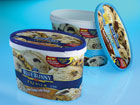
Wells’ Dairy credits a switch to an injection-molded polypropylene container with a snap-in, tamper-evident tab for helping drive a 12.5% gain in Blue Bunny ice cream sales last year. Source: Basell North America Inc.
A leading private-label ice cream supplier, Le Mars, IA-based Wells’ decided in 2005 that its Blue Bunny brand could benefit from a more innovative package than the cylindrical paperboard container that continues to serve Wells’ private-label products. Dreyer’s Grand Ice Cream was having great success with the bite-sized Dibs novelty items in a small plastic tub, and Wells’ marketers thought a polypropylene 56-oz. container could bring excitement to its ice cream business, too. They were right: Blue Bunny sales spiked 12.5% in 2006, according to IRI retail scan data, making it one of the fastest growing brands in the country. “It’s really going gangbusters in the Northeast, with grocers broadening the assortment of Blue Bunny products in their freezers,” reports Lesley Bartholomew, Wells’ communications manager.
To execute the change, Wells’ spoke with several injection molders before selecting Omaha-based Airlite Plastics Co. Tooling and robotics systems had to be built to execute an in-mold labeling process which fuses a preprinted label to the polypropylene during injection molding. The five-color label is offset printed in Belgium by Verstaete and “enables us to have cutting edge graphics that help the product stand out on the shelf,” adds Bartholomew. The container also has a tamper-evident lid that snaps into a depression in the lip and a tapered profile that makes scooping easier and eliminates what Wells’ marketers term “knucklemuck.”
A key supplier to Airlite is Basell North America Inc., Elkton, MD. Coincidentally, Basell also supplies the resins used to make the Dibs container. However, the Blue Bunny container is bigger and heavier, so a more impact-resistant resin was needed. Basell’s EP390S copolymer fit the bill. “Theoretically, dropping it 3 ft. onto a concrete floor at -40ºF will not crack or break it,” according to Dave McKeeman, Basell’s marketing manager, rigid packaging. “It can withstand microwave temperatures, and Wells’ is encouraging reuse of the container with a ‘dishwasher safe’ statement on the container.”
Instituting the changeover in Le Mars was a big commitment. “We had to change the fillers, the lidders and adjust all the downstream material-handling equipment,” says Bartholomew. A two-week scheduled shutdown at one of Wells’ plants provided the necessary window.
For more information: Dave McKeeman, Basell, 410-996-1314,dave.mckeeman@basell.com
